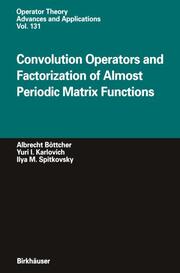-
Zusatztext
-
Many problems of the engineering sciences, physics, and mathematics lead to con volution equations and their various modifications. Convolution equations on a half-line can be studied by having recourse to the methods and results of the theory of Toeplitz and Wiener-Hopf operators. Convolutions by integrable kernels have continuous symbols and the Cauchy singular integral operator is the most prominent example of a convolution operator with a piecewise continuous symbol. The Fredholm theory of Toeplitz and Wiener-Hopf operators with continuous and piecewise continuous (matrix) symbols is well presented in a series of classical and recent monographs. Symbols beyond piecewise continuous symbols have discontinuities of oscillating type. Such symbols emerge very naturally. For example, difference operators are nothing but convolution operators with almost periodic symbols: the operator defined by (A<p)(x) = L: ak"kX. Moreover, a convolution operator on a finite interval is, in a sense, equivalent to a convolution operator on the half-line whose symbol is a 2 x 2 oscillating matrix function: consideration of the convolution operator with the symbol f(x) on the interval (0, A) leads to the convolution operator with the matrix symbol on the half-line (0,00). Notice that eVl(x) is oscillating even if f(x) is continu ous. We finally mention that convolution operators with oscillating symbols have properties that are not shared by operators with continuous or piecewise continu ous symbols.
-
-
Kurztext
-
An introduction to convolution operators with matrix-valued almost periodic or semi-almost periodic symbols. The material covered ranges from classical results through to a first comprehensive presentation of the core of the theory of almost periodic factorization up to the latest achievements.
-
Detailansicht
Convolution Operators and Factorization of Almost Periodic Matrix Functions
Operator Theory: Advances and Applications 131
ISBN/EAN: 9783764366728
Umbreit-Nr.: 1667992
Sprache:
Englisch
Umfang: xi, 462 S.
Format in cm: 2.7 x 23.8 x 17
Einband:
gebundenes Buch
Erschienen am 01.02.2002


